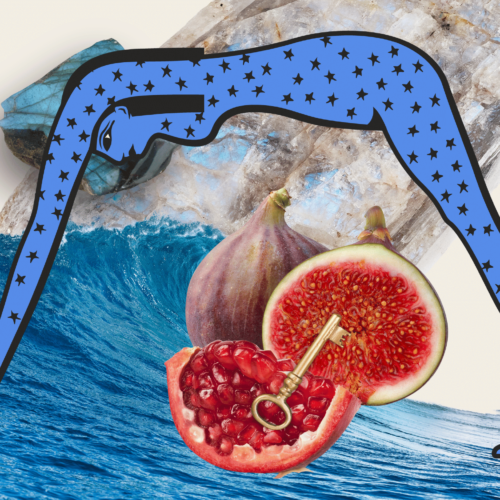Did you know you have an upper limit to your capacity to experience joy? Yes, you, sweet one. The concept of limitless living is jettisoning into the collective consciousness but causing reverb because it skips over the deep work of identifying and addressing your limiting beliefs (and it can trivialize systemic and personal trauma). Here’s an exploration of how upper-limit problems hinder your ability to experience abundance, joy, and limitless living—and a ritual to release old narratives and invite abundance.
An Introduction To Limitless Living
I first heard this buzzword on Instagram, and I immediately recoiled. My bulls*t and toxic positivity detectors are strong, courtesy of experience. Too often, spirit workers espouse these terms while neglecting systemic challenges and the beliefs we’ve inherited from patriarchy and white supremacy.
These self-help guides accompany phrases like limitless reality or limitless living with claims of becoming a millionaire+ in some crazy short amount of time, buying your dream house, and making a lot of money while only working a few hours a day. Many of these people are also proselytizing some toxic sh*t that feels like a multi-level marketing scheme. I don’t want to link to dignify these predatory people and give them my external linking cred, but they abound online.
But I couldn’t get this phrase out of my mind, so I decided to stay curious. Here’s how I’ve integrated the concept of limitless reality into my deep work on my capacity for joy.
Limitless living derives from the Law of Assumption, coined by Neville Goddard—if you assume something already exists, it will arrive and manifest into existence. You can live a limitless reality if you assume you already have everything you desire. You are the proverbial damn to the flow of your dream life. (And hey, babe, join the others who’ve awakened and are now living in this limitless reality! It feels like a rainbow-filled metaverse, huh? Where terrible things don’t happen, and everyone is singing karaoke on key?!)
But we all know that a damn in a river is also part of an ecosystem where anything influences everything.
Follow me deeper, but somewhere more tangible. Your limiting beliefs prevent you from experiencing your most full life. If you reprogram your limiting beliefs, you will experience more abundance, pleasure, joy, and beyond.
But What Are Limiting Beliefs? Say You
I thought you’d never ask. Limiting beliefs are attachments to concepts and arbitrary rules that you’ve internalized as truth, usually learned in early childhood. You can thank your ancestors for these rules. Well, more kindly, your ancestors survived because of these beliefs in many cases; for example:
- If I shine too brightly, I will outshine others and make them feel bad
- If I am wealthy, I will be greedy and selfish
- If I attract attention, I am deserving of criticism
- If I have pride in my work, I lack humility
Limiting beliefs are often a symptom of low self-worth. Keep reading to explore and release your limiting beliefs through ritual.
The Connection Between Limitless Living and Your Upper Limits
While pondering this maybe whoo-whoo concept of limitless living, I also read Gay Hendricks’s book, The Big Leap: Conquer Your Hidden Fear and Take Life To the Next Level. I hypothesize that limitless living is achievable and authentic by addressing your upper-limit problem.
Dear Reader: Below is an oversimplification of a profound body of psychological research and knowledge. Please read the book.
Your Subconscious Is a Nasty Self-Sabotager
Gay Hendricks, in his book The Big Leap, states that everyone has an upper limit to their capacity to experience enjoyment. Hendricks calls this an “upper limit problem.” Here’s a synopsis, but just get the book. These upper limits stem from beliefs, often contradictory, that a person creates or inherits. For example, outshining others is terrible and hurtful; your existence is a burden, etc. A few symptoms of an upper limit problem are worry, criticism, and breaching integrity.
In simple terms, when you reach your upper limit, your subconscious finds ways to self-sabotage through:
- Punishment
- Prevention
- Protection
Here a couple of examples: Have you ever created or worked hard for an opportunity, then fallen sick on your big day? Have you ever won a top award at work only to get pulled over on the way home from your celebration ceremony?
You can only dissolve the problem by addressing four underlying fears or beliefs behind it:
- Feeling flawed and unworthy of success
- Fear of disloyalty and abandonment
- Fear of the burden of success
- Fear of surpassing or outshining others
Whoah. Yeah, read all that one more time.
And, an upper limit problem’s symptoms include worry, criticism, and breaching integrity. You might say, yeah, I don’t have those ailments. Lucky you, but read on anyway because I call bluff. Or, you might say, how do I overcome those ailments? Sadly, these are not things to overcome, conquer, or cast aside.
These tender wounds need a gentle voice of encouragement and the medicine of healing and integration. Keep reading for a ritual to guide you.
Here are examples:
When Carmy Gets Stuck In The Walk-In
This pop culture reference comes to mind: the scene in Season 2 of The Bear when (spoiler alert) Carmy gets locked in the walk-in freezer on the opening night of his restaurant, followed by his blame-based rant about how he lost focus because of his feelings for his new girlfriend. He says, “I don’t need to receive any amusement or enjoyment… because no amount of good is worth how terrible this feels.”
Earlier in the show, you get a glimpse into the codependency, enmeshment, and martyrdom in his family of origin. He admits to his “shoedrop” hesitation when happy with Claire. So, what do you think his upper limit problem is? We can speculate, but regardless, it is an apropos example: upper-limit blocks prevent you from experiencing the joy you desire and work hard to create space for.
When I Spilled Hot Tea On My Coochie
Here’s a good one for you. I went to bed early at 8:30 pm (we covet rest and sleep with a toddler in our house). I snuggled up alone in bed with hot tea and my iPad. It was the one night all week when my husband didn’t have a late-night work call, and I was not responsible for bedtime.
As I climbed into bed and heard my toddler still up and talking, I thought, “I don’t deserve to rest. I should do something productive.”
There’s always laundry and dishes and a million things to do while running a business and a home. I ignored the thought. Within minutes, I gracefully knocked the tea from my right hand with my left hand and spilled burning hot tea on my coochie, upper thighs, iPad, and sheets. I made a noise that had my family run into the room to see if I was okay. I spent the rest of the evening washing sheets and the mattress protector and icing my coochie.
I certainly inherited a belief that productivity makes me worthwhile and rest makes me lazy. I am not deserving of rest. I tried to ignore this mind trash but didn’t sit with it or address it. (Yes, I am ready to upgrade my upper-limit problem for real rest.)
Limitless Living Wants a Bedrock of Self-Worth
As witnessed above, I’ve got an upper-limit problem. So, my subconscious may thwart any attempts at limitless living. The antidote is to expand your capacity to experience enjoyment, love, abundance, and whatever your heart desires. It’s time to clean up the house and work through the beliefs underpinning my upper-limit problem. Want to join me on this adventure?
Your Ability To Experience Joy Is a Muscle
My philosophy is that my ability to experience anything is a muscle. I need to flex it, use it, work it. Apply this to your ability to experience prosperity and abundance. Add a bedrock of worthiness and self-love to receive anything genuine and loving.
Here’s what I’m committing to:
- Spot how my subconscious intervenes during moments of joy
- Stay curious, to the frequency of wonder even, about these habits and beliefs
- Build a bedrock of self-love (and release low self-worth)
- Play and creativity—and setting aside every Friday and early weekday mornings to write, paint, and journal
- Pause when I say or think limiting things, like idioms I picked up
- Presence. I will time warp and extend all moments of joy, like holding my baby, basking in the sun, or feeling the flow when writing
Your ability to experience joy mirrors your ability to experience grief and other challenging emotions. When you are curious about all variations of your feelings, your capacity also grows.
Once you’ve grappled with these upper limits, Hendricks advocates finding your zone of genius—this is how you unlock your full potential and experience lasting satisfaction. F*ck, that is a tall order. Stay tuned.
Where Limitless Living Falls Short
It does not align with me to advocate for limitless living without dismantling the systems that gave us these beliefs. Trivializing systemic and personal trauma perpetuates harm, and I find “coaches” and spiritual people who only offer light work bring way more shadows to the conversation.
Limitless living philosophies leave significant gaps regarding trauma, conflict, violence, and harm. In contrast, confronting limiting beliefs also means confronting the limiting beliefs of society, extricating the beliefs of patriarchy and white violence from our inner worlds (like women expecting free labor from other women?!), and our aversion to restoring justice in the face of harm, thus perpetuating more harm. (For the record, Hendricks writes several times about Bill Clinton, including how he sabotaged his success by lying on national television—but he does not comment on Clinton’s abuse of power, which irked me while reading.)
You bought your dream house with the Law of Assumption? F*ck that. You are perpetuating oppression and capitalism.
However, perhaps identifying these beliefs is a portal to systemic change. The belief that, as a woman, I need to be productive and do not deserve rest is imbued with patriarchy. Extricating that belief in myself creates space for others to prioritize rest.
I cannot rework my beliefs without dredging up some dark sh*t. When I confront limiting beliefs I have absorbed, I feel grief. Who gave me these f*cked-up beliefs? Why did I need that to survive? I am working toward compassion for the evolution inherent—and all versions of self—in this process, which I suppose is revolutionary.
How To Reprogram: Catalog Your Idioms
We all have catchphrases or idioms we say and think. These offer an insight into our limiting beliefs. Take a peek-see: identify your idioms and excavate the underlying limiting beliefs. Take your time and notice what you tell people and yourself in the following days, especially those offhanded, indirect phrases you use to make others comfortable.
Here are the idioms that I use regularly and how they reflect limiting beliefs and an upper-limit problem:
1. Everything Is Temporary
This phrase works well for me when times are tough, but I believe it in good times. It is a variation of “this too shall pass.” But when I experience positive emotions, they also feel so temporary that I can’t enjoy them and that something “bad” will surely come along and disrupt any “good.”
2. There’s Always Something
I picked up this phrase for undermining hard times, whether a disrupted day due to sickness or a basement flood. This program also reinforces the “shoe drop” idiom: “I’m waiting for the other shoe to drop.”
You may have some healthy idioms in there that work for you. I found one: I have a 100% chance of working things out. The universe has a 100% chance of looking out for me. Thanks for that one, subconscious.
You can invite the contrasting energy once you identify your limiting beliefs.
Spell Cast: Release / Embrace Ritual
Ingredients
- Paper
- Pen
- Candle
- Salt
- Crystals that absorb negative energy, like black tourmaline
- Crystals that amplify affirmations, like rose quartz and amethyst
Note: These ingredients are a guide. I believe in intuitive spellcasting. Use the colors, stones, and ingredients that you feel called to. You know best.
Write I Clear / I Embrace
Write a list of the idioms you’ve inherited and the limiting beliefs you’ve excavated during your exploration. Now, write the reverse. Use this format:
I clear [insert belief] / I embrace [insert reverse].
As you work through this exercise, notice where you feel the belief in your body and where you feel the reversal.
Example:
I clear the belief that I am undeserving of rest / I embrace radical rest and self-love.
I recommend that this part be intuitive. You know best. Cast a circle with salt. Use a candle to safely burn a written list of what you’re releasing. Use crystals that absorb negative energy during your release, like black tourmaline, and crystals that amplify affirmations when you embrace, like rose quartz or amethyst.
You may add, “I’ll know I’m experiencing this when I feel [insert feeling].
Example:
I clear the belief that I am undeserving of rest / I embrace radical rest and self-love. I’ll know I’m experiencing this when I feel calm.
Say This Out Loud When You Release
Thank you for protecting me. I release you in honor of my growth. I embrace my full capacity to experience joy in this lifetime and all other timelines.
You can swap in any limitless-living noun for the word joy: prosperity, abundance, love, trust.
Revel In Moments of Joy
Seek a moment of joy, and time warp your experience in the moment. Notice the physical sensation of pleasure in your body and where it appears. Breathe into it. Make it stretch and expand and take up more space and time. Notice any thoughts, anxieties, fears, or narratives interrupting the flow of that physical and emotional sensation. Say to yourself that these interruptions of your limiting beliefs are no longer welcome in these moments of joy.
Work with one of these phrases (and imbue your healing crystal with this affirmation for a physical reminder).
- My capacity to experience joy is expansive.
- I am expanding my capacity to experience joy.
- I embrace my full capacity to experience joy in this lifetime and all other timelines.
All this and more and better, with harm to none.





